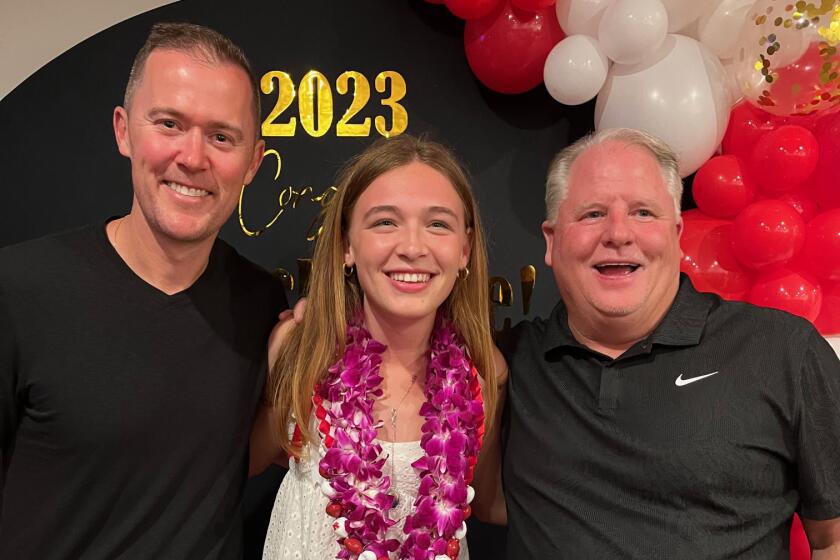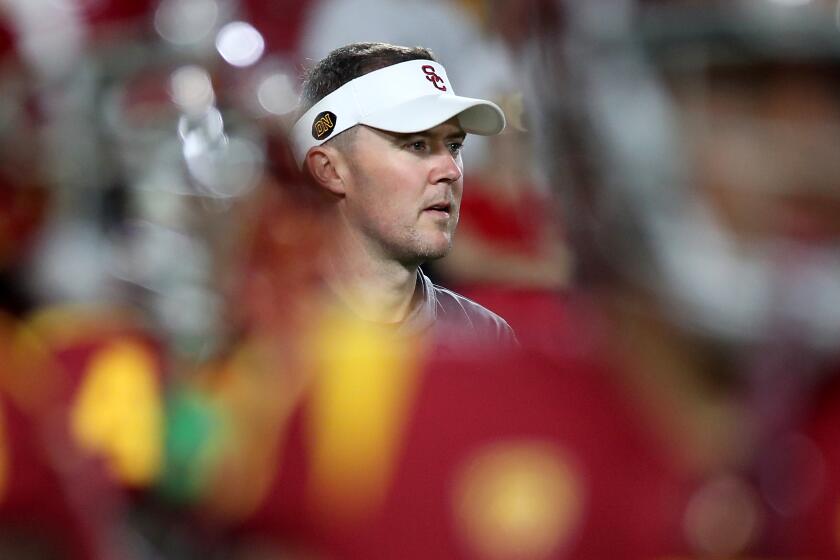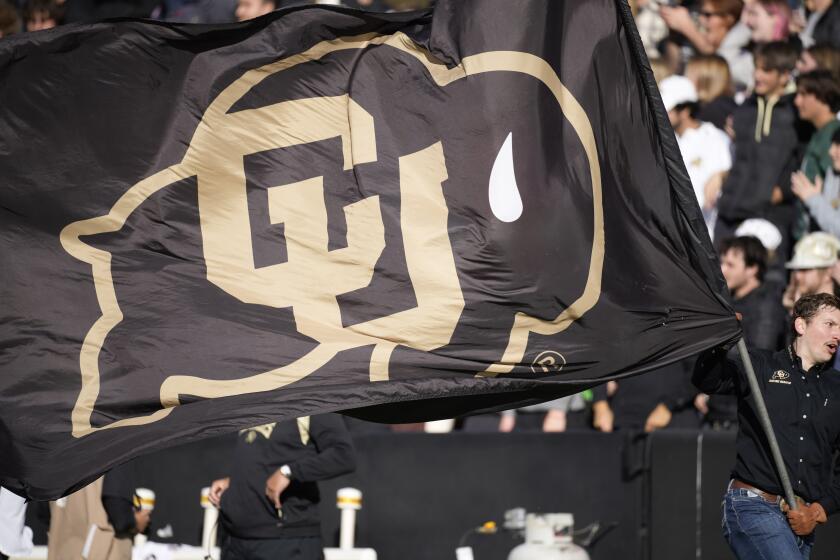
- Share via
As their old conference ticks its way toward a shriveled, uncertain future — schools skedaddling seemingly by the day — UCLA and USC have formally commenced the countdown toward a more assured fate.
A clock that will be unveiled by UCLA on Wednesday morning as part of a transition website counts the days, hours, minutes and seconds until the school and its cross-town rival officially become members of the Big Ten Conference on Aug. 2, 2024.
“That date is burned in our minds,” said Sandy Barbour, the former Penn State athletic director who is part of USC’s transition team.
The clock represents an opening salvo in the schools’ final year of Pac-12 membership as they try to delicately walk the line between respecting the past and embracing the future. They have already spent more than a year adopting one mantra of John Wooden, the crossover basketball star who played for Purdue in the Big Ten before coaching at UCLA in the conference that would become the Pac-12.
If failing to prepare is preparing to fail, as Wooden liked to say, then UCLA and USC have one less worry. They’ve spent countless hours planning for the unprecedented change that awaits as part of life on one end of the first coast-to-coast conference.
“Our mindset right now,” said Matt Elliott, the chief strategy officer for the UCLA athletic department who is also the point person for its transition team, “is to make sure that we are ready for everything that comes when we join the Big Ten. We want to remain elite in everything we do when we get there.”
Fighting until the end after a kidney cancer diagnosis, UCLA defensive coordinator Bill McGovern and his family received some unexpected help along the way.
The benefits of Big Ten membership should help in that endeavor. According to some projections, UCLA and USC stand to make between $65 million and $75 million per year in media rights fees — likely more than double what they would have pocketed by staying in the Pac-12 — while gaining a larger recruiting footprint and increased national exposure.
“You’re not going to play a game later than 8 [p.m.] o’clock on the East Coast because of the time slots the Big Ten has,” UCLA football coach Chip Kelly said, “so the exposure of being shown around the country [at a more reasonable hour] is a positive.”
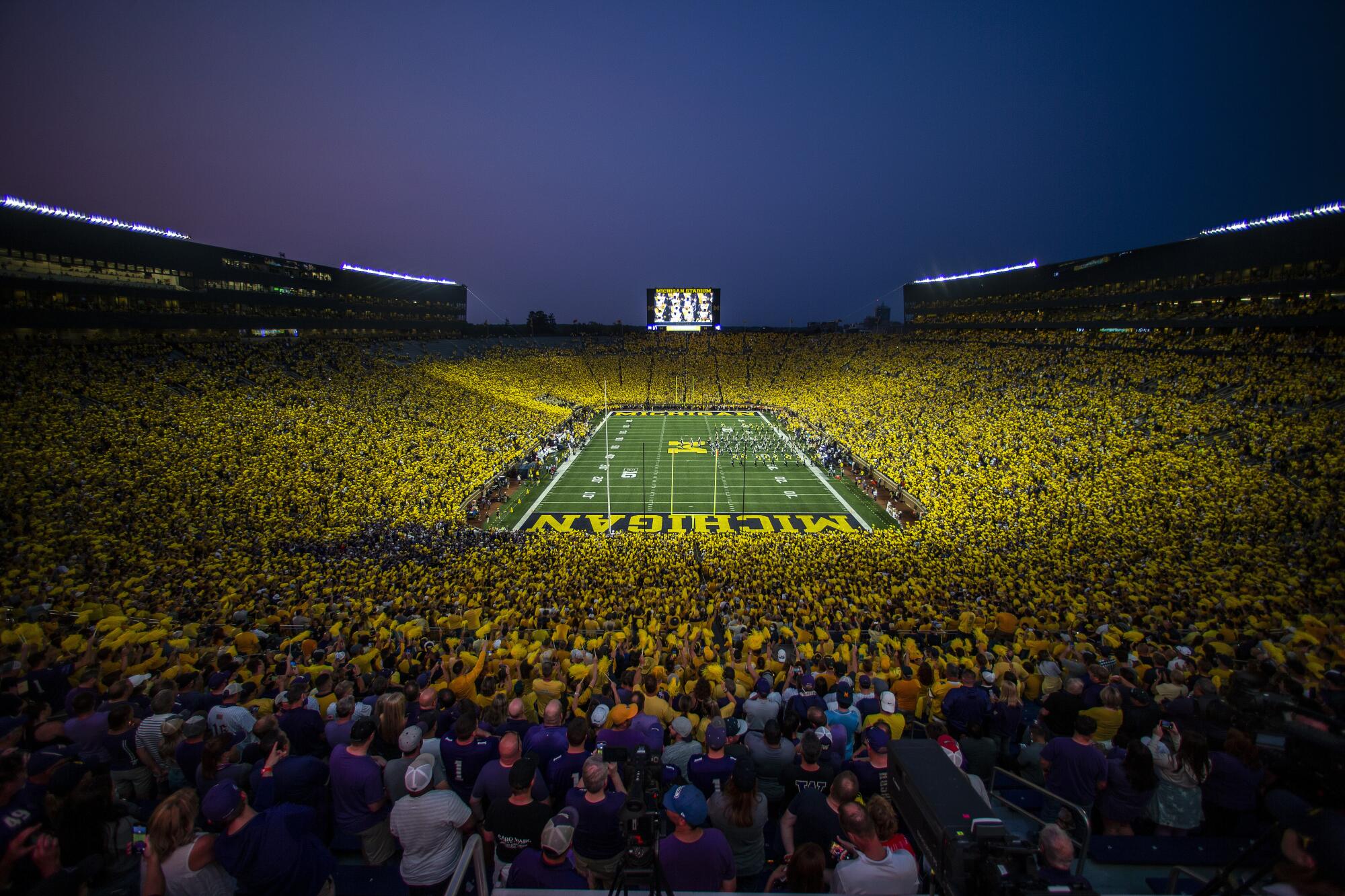
Scheduling is just one component of transition planning. At USC, that process has been complicated in recent months by the absence of an athletic director after the school parted ways with Mike Bohn. The Trojans were already taking a different approach than that of their rival by engaging the outside consulting firm Huron, though the group is largely composed of former Big Ten insiders. In addition to Barbour’s ties to Penn State, consulting partner Kevin Weiberg was once a Big Ten associate commissioner and vice president of the Big Ten Network.
“I knew who to go to,” Barbour said. “I think it’s been helpful to not have to make 20 calls to find out who we need to go to in the conference to talk about a particular thing.”
Across town, the transition has been divided into three phases that come with their own sports analogies — gathering information to create what Elliott called a scouting report, making a game plan to maximize that information and implementing the plan for the school’s kickoff in its new conference.
Officials from the Big Ten and its eponymous television network have visited campus to meet Bruins athletes, coaches and administrators while also touring facilities to understand the school’s infrastructure. Elliott spoke with athletic officials at other schools that had completed conference moves or were in the middle of the process, seeking suggestions to ensure UCLA didn’t overlook any part of its transition.
The Bruins are about to start the final phase of their plan after athletes conveyed through surveys and committees that nutrition, mental health and academic support were top priorities.
“They asked what’s lacking, what’s different, like compare yourself to the Big Ten schools,” said Lauryn Carter, an outfielder on the softball team who served on a finance committee. “We had a lot of conversations about that, like, what is this school providing that we’re lacking? What is going to make us stand out in the Big Ten?”
UCLA and USC will face plenty of challenges during their first season in the Big Ten. Here’s a rundown of who UCLA and USC will face in 2024 and 2025.
Suggestions included providing a dedicated nutritionist for each sport, standard practice among some Big Ten schools. More food offerings were requested from athletes outside of the football and basketball teams that enjoy catered meals at their practice facilities.
No proposal was off limits, however impractical. There was even brief discussion about moving from the quarter system to the semester system to more closely align with most Big Ten schools.
“It was interesting, putting all these different ideas on the table,” said Caedon Kottinger, a UCLA baseball pitcher who served on a competitive greatness committee, “to see how we would best succeed in the Big Ten.”
As a result of the feedback, a pilot program was unveiled in the spring to serve lunch every day to dozens of athletes on a cross-section of teams. By the 2024-25 school year, the Bruins’ first in the Big Ten, that will increase to breakfast and lunch for every team.
UCLA has committed to spending as much as $10.32 million a year to enhance support in nutrition, mental health and academic tutoring along with more chartered flights to minimize time away from school as officials try to mitigate the travel challenges that accompany trips to the Midwest and the East Coast.
USC declined to divulge if it was committing extra financial resources to those same areas.
Conference football schedules for the 2024 and 2025 seasons — with dates to be announced later — were released in June. USC will travel to Maryland, Northwestern, Penn State and Purdue, in addition to UCLA, during their first year in the Big Ten. The Bruins will take trips that season to face Indiana, Iowa, Michigan and Rutgers.
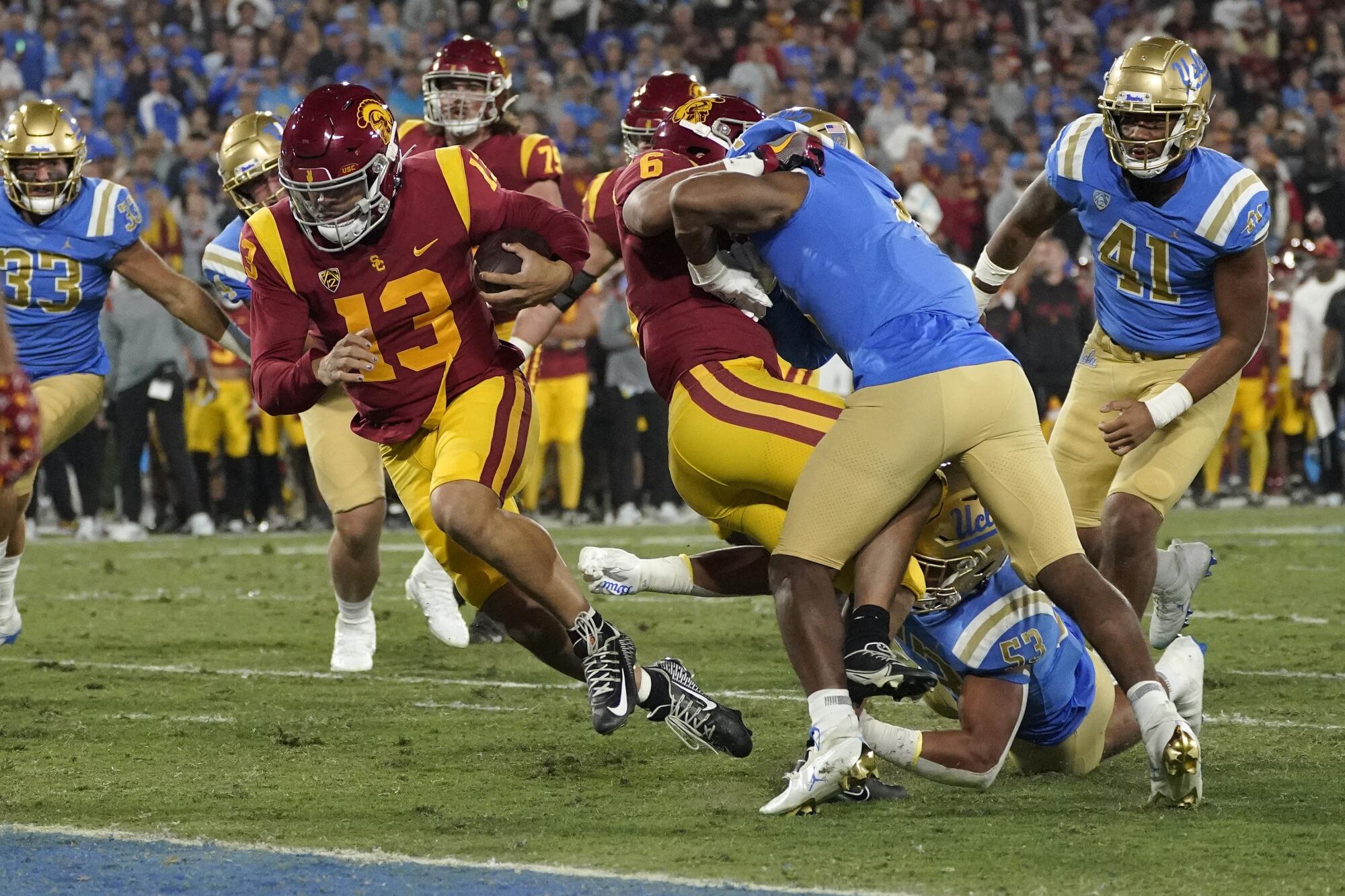
Many questions remain. Will UCLA hire a second football equipment truck driver to navigate all those extra miles? Should the Trojans arrive in State College, Pa., two days before their game against Penn State to acclimate to the three-hour time change?
Answers are expected to trickle in over the next year. The schools are engaging sleep specialists, nutritionists and mental health experts — among many others — to devise best practices that will maximize performance while lowering the strain on athletes.
The travel burden is expected to be especially heavy for Olympic sports teams that take extended trips to play multiple games. UCLA and USC are working with the Big Ten to design conference schedules that create the least amount of travel, keeping athletes away from campus as little as possible.
“Of course, there’s always hesitation from Olympic sports — kind of like, ‘OK, where are we going to fall in this?’” said Margueritte Aozasa, coach of UCLA’s defending national champion women’s soccer team. “And I think UCLA has been super supportive from Day 1 and very transparent about like, Hey, we’re going to try as best we can to support everyone here.”
One proposed solution has been so-called jamborees involving multiple teams meeting in a central location to play several games. In some scheduling models, select teams could actually play fewer road conference games.
The 11 Big Ten women’s gymnastics teams could compete in tri or quad meets where three or four teams convene at a site in the Midwest to lower the travel burden while ensuring that each team faces one another during the regular season.
“Meeting some of those teams more in the middle [of the country] might be a good option for that,” said Janelle McDonald, the UCLA women’s gymnastics coach.
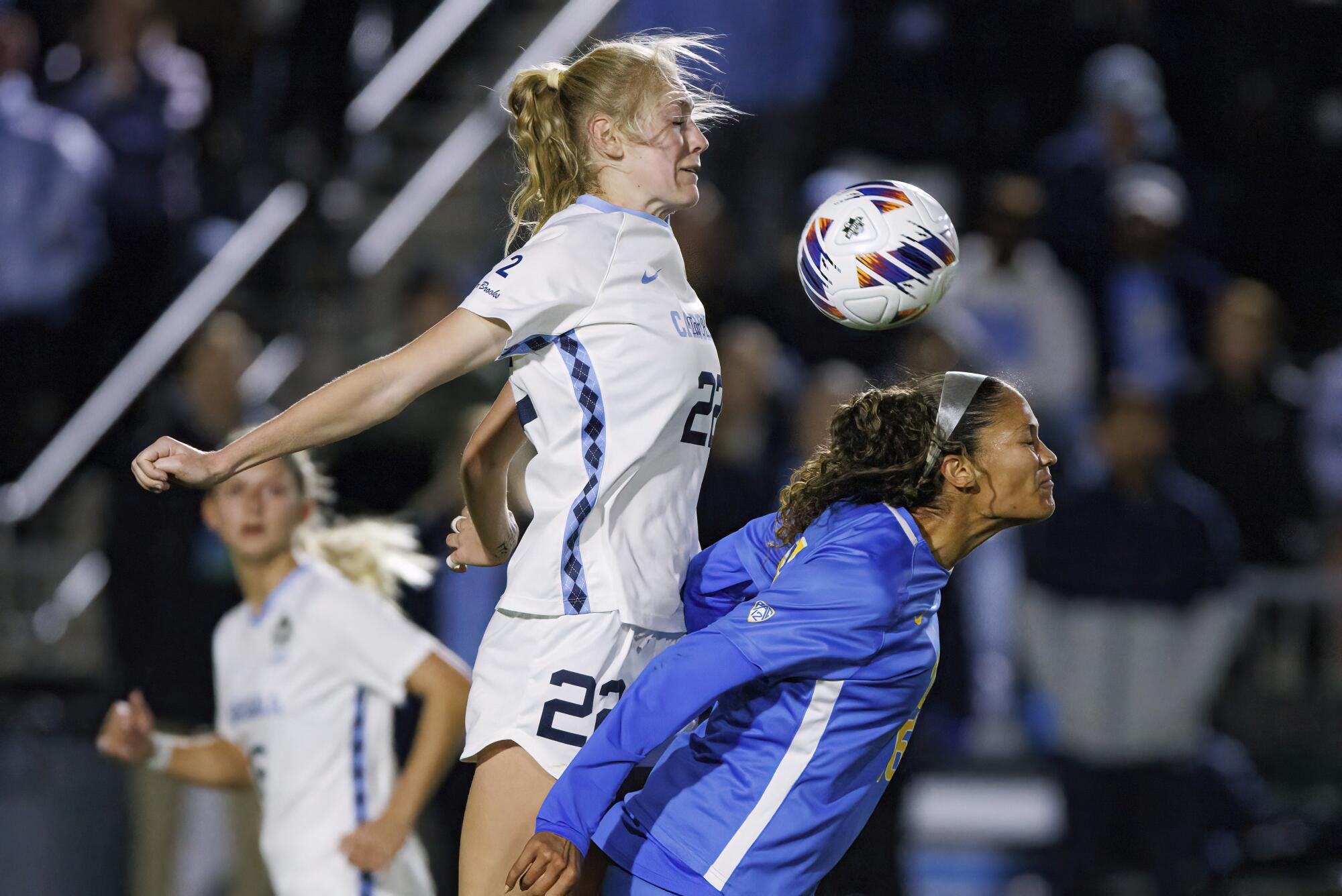
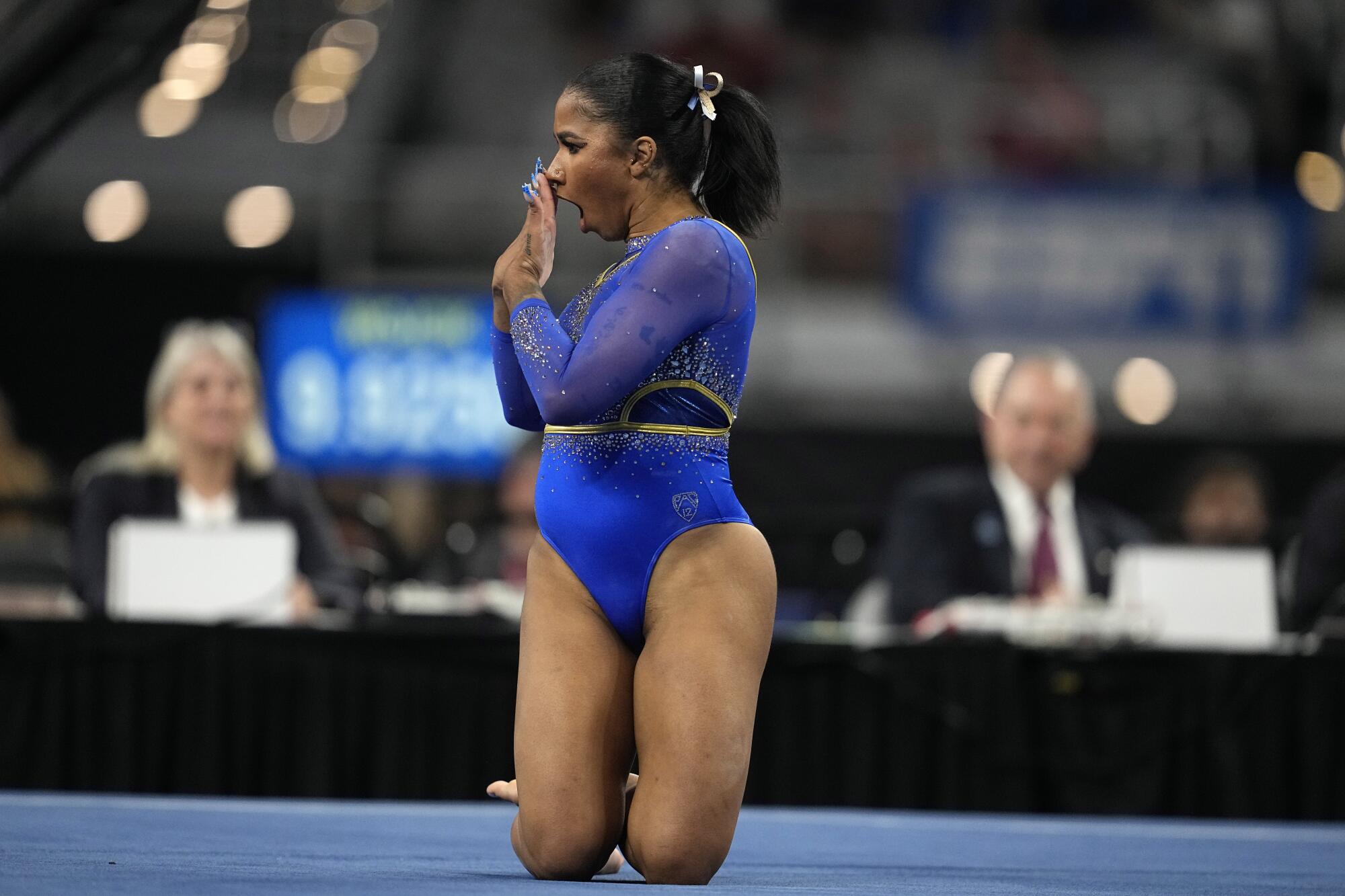
Reaching their destination most efficiently could involve multiple teams from UCLA or USC traveling together to play the same school — or, the rivalry gods be damned — Bruins and Trojans taking the same chartered plane. The latter scenario could easily work where one school was playing at Illinois and the other at Purdue, which are roughly 90 miles apart.
“Oh, I feel like that could be kind of fun,” Aozasa said with a laugh of traveling with the Trojans. “If we had to travel somewhere with [UCLA women’s] volleyball, that would be a dream. And in terms of USC, that could be a little bit different, but our approach to that is that it serves us to work together.”
Aozasa said a Big Ten schedule dotted with Midwest and East Coast teams could benefit the Bruins because it would better prepare them for the NCAA tournament, which tends to include more teams east of the Mississippi River. The UCLA and USC women’s soccer teams will also experience extra preparation from a conference tournament, which did not exist in the Pac-12.
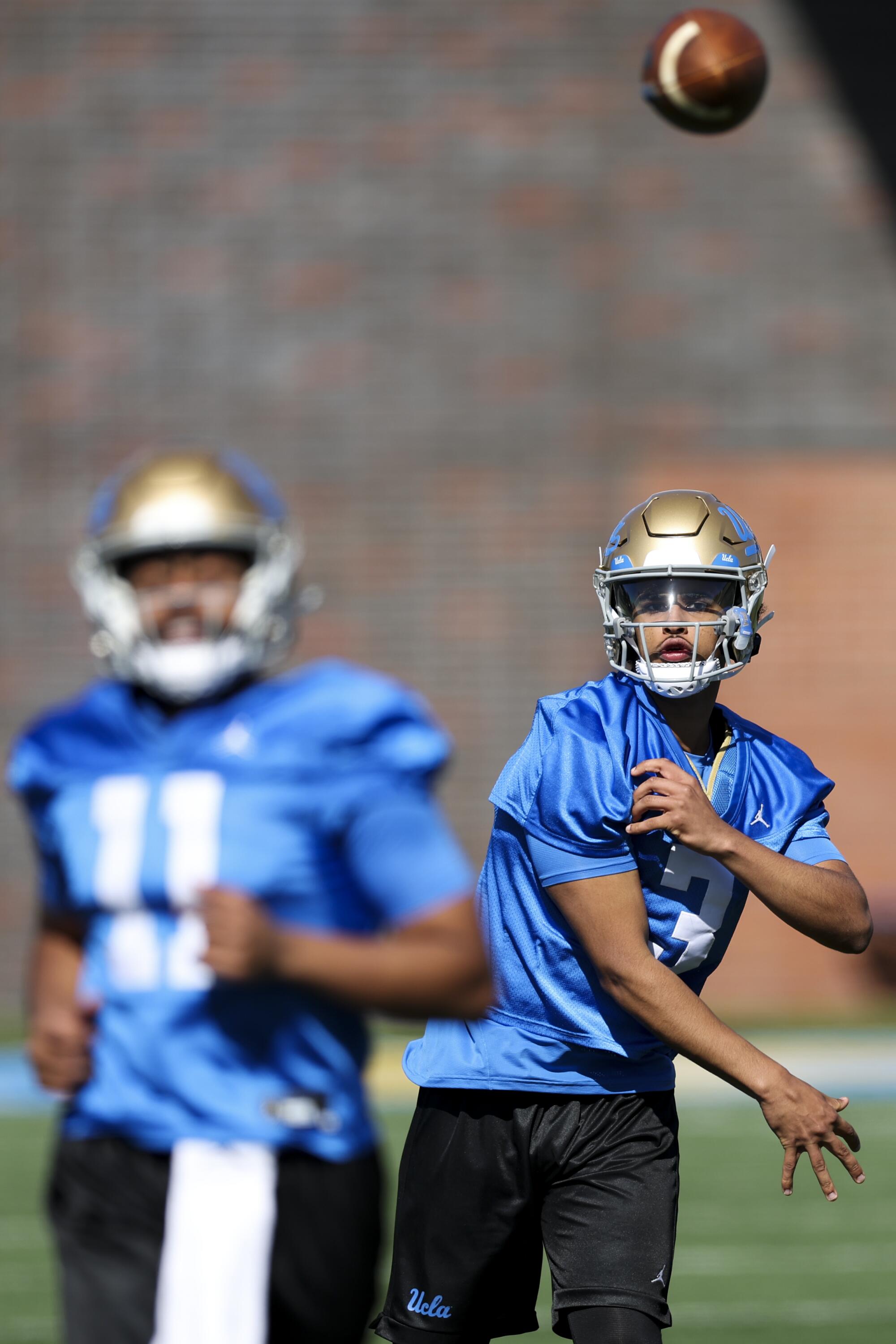
The recruiting reach of the Bruins and Trojans figures to expand, with two caveats — both schools will likely continue to draw heavily from talent-rich Southern California and already go after the best prospects in every sport regardless of ZIP Code.
But one early payoff of playing games in 12 states can be found in Westwood. UCLA freshman quarterback Dante Moore, the highest-rated recruit at his position to pick the school in at least two decades, said he chose the Bruins in part because he would get to play a couple of games each season near his Detroit home.
“I still think your recruiting base is always going to be somewhere within driving distance of your campus, but there’s always exceptions,” Kelly said. “There’s not a hard and fast rule. I think the kids from California are excited about playing at a Michigan or at a Penn State or at an Ohio State.”
Elliott, who is leading UCLA’s transition efforts, said school officials won’t exhale a year from now once the conference switch is complete. The Bruins will continue to build upon a legacy that includes 121 NCAA team titles by making adjustments on the fly — mid-flight over Illinois, if necessary.
Tasked with cleaning up Larry Scott’s mess, George Kliavkoff got little help from college presidents, with USC, UCLA and Colorado following the money.
“When we’re actually doing this we’re going to be looking at the three phases,” Elliott said. “Did the team create their actual specific plan that got them ready for that trip, did they prepare for that team; then did we do everything possible so our team could perform at the highest level while they were there — did they get the right amount of sleep, did we arrive at the right time, did we leave at the right time, did we have the right food when they arrived, provide the right snack; and then, did they recover when they got back as fast as possible?
“If we can do those things as effectively as possible with all those pieces — whether it’s travel, whether it’s equipment, etc. — then I think we’ll be really successful.”
Times staff writer Ryan Kartje contributed to this report.
More to Read
Go beyond the scoreboard
Get the latest on L.A.'s teams in the daily Sports Report newsletter.
You may occasionally receive promotional content from the Los Angeles Times.

